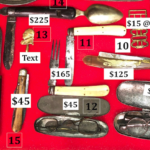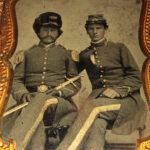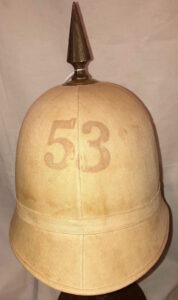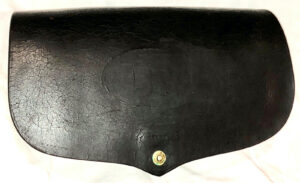
U.S. M1881 Dress Helmets
U.S. M1881 Dress Helmets – Black felt covered hats with their original brass insignia and spike; most of these helmets are labeled as having been the products of the period military supply companies – Ridabock and Baker & McKenny; one helmet has its leather sweatband marked “W.H. HORSTMANN CO., 1898”, in two lines. Some of the crown interiors have soldier’s names and regimental designations written on the lining. Each helmet retains its original brass spike and front insignia, side buttons and chinstrap. All helmets are in reasonably good condition, although one has some minor damage to the interior. Each helmet has a different branch of service designation exemplified by service branch insignia superimposed on the front, sheet brass, stamped eagle, in a silvered metal, with accompanying matching brass side or chinstrap buttons, each embossed with the specific branch of service. Branches of service represented in this grouping of helmets are: electrician, infantry, hospital department, medical department and engineer.
- M1881 Electrician’s Helmet – SOLD
- M1881 Hospital Department Helmet – SOLD
- M1881 3rd Infantry Helmet – SOLD
- M1881 Medical Corps Helmet – SOLD
- M1881 Engineer’s Helmet – SOLD
Model 1881 Dress Helmet
by David L. Velleux
The Model 1881 Dress Helmet was worn only for full dress events. The helmet evolved from the earlier Model 1872 helmets worn only by the Cavalry, Light Artillery and Signal Corps. In 1881, the new helmet design was adopted for use by all enlisted troops and for officers of the Infantry, Cavalry and Artillery. (General and Staff officers continued to wear a chapeau de bra as they had for many years…) For enlisted troops, the helmet was made of black felt, while officers could buy a helmet of black cloth over a cork or felt base. Atop the helmet of all mounted troops is a brass plume holder, resting on a brass base having an oak leaf and acorns motif, while the plume holder itself is engraved with an eagle and star. For enlisted men, a thin rod with two circular plates at the top clamps the base of the horsehair plume and rests atop the plume holder, while officers had a similar device to let the plume appear like it was fountain sprung from their heads. The plume’s color depended on the branch of service the soldier was in: white for mounted Infantry officers, red for Artillery and yellow for Cavalry.
The Arms of the United States forms the large insignia on the helmet’s face. Again, depending on the branch of service, one of four different eagle designs formed the insignia. Enlisted troops in branches other than the “Big Three” wore the general services eagle, while dismounted officers from another corps wore either an Infantry or an Artillery plate. For all Infantry, Artillery and Cavalry personnel, a small white metal numeral of the assigned regiment is affixed by small wires to the shield of the eagle plate. Other corps had a small device to signify their assigned branch. For all mounted troops, the helmet cord is hung on the helmet from two devices. For enlisted troops, the cord’s color matched that of their branch, while all officers wore a two-piece cord of braided, gilt thread. The cord’s braided bands drape over the front and back of the helmet. The remainder then falls to the left shoulder and gets secured by a slide, goes around both sides of the head and gets secured by another slide, then around both sides of the right arm and gets secured by a third slide, then the two lozenge ends are secured to a button on the frockcoat and simply dangle.
For all officers, a brass chain chinstrap hangs from two corps-faced buttons with hooks on them. All dismounted officers of Infantry and Heavy Artillery wore the same helmet and base plate, but with a plain brass spike on top. Those officers also wore the brass chain chinstrap. It was draped across the helmet’s face, from a shield hook on the helmet’s upper right back to the left helmet button, when not being used. Enlisted troops had a simple leather band for a chin strap, with two corps-faced buttons on the sides.






